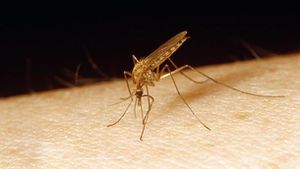Malaria Resistance and Sickle Cell Trait
Introduction
Sickle Cell Disease
Sickle cell disease is an autosomal recessive disease caused by hemoglobin S, an oxygen-carrying protein in blood cells. A single point mutation in the nucleobase sequence of chromosome 11 causes the sixth amino acid in the hemoglobin protein, glutamic acid, to be replaced by valine, changing standard hemoglobin beta into hemoglobin S. The sickle shape is caused by hemoglobin’s resulting structural change, and it is from this structure that the disease gets its name.
When an individual is homozygous recessive for hemoglobin S, severe symptoms start to occur. The most infamous being anemia, which can, in turn, cause shortness of breath, jaundice, and hypertension. This biggest problem is blood clotting in vessels, which could lead to damaged tissues that rely on the clotted vessels. However, Individuals heterozygous for the trait are not prone to the same severity of symptoms as homozygous recessive individuals.
Despite the disease’s lethal symptoms, it protects the carrier from malaria, which is why sickle cell alleles are most common in people of African descent (about 10% of people of African descent carry an allele), but also in people of Mediterranean and Hispanic ethnicities, where malaria is prevalent.
Malaria
Transmission
Malaria is caused by parasites of the genus Plasmodium. The anopheles mosquito transmits the disease through its saliva, but it must have first received the Plasmodium parasite from an infected human from which it took blood. Malaria can be transmitted without anopheles mosquitos if blood is somehow transported from an infected human to someone else. Some possible methods of transmission include, but are not limited to, blood transfusions, organ transplants, sharing needles, and from mother to child during pregnancy.
Life Cycle
The parasite enters the host as sporozoites and proceeds to the liver, where they replicate asexually into merozoites. This usually takes about 10 days to a few weeks (depending on the species of Plasmodium) and is known as the exoerythrocytic phase.
The merozoites eventually overwhelm the liver cells, causing them to burst. Once the host liver cell bursts and releases the Plasmodium, it finds its way into the host’s blood stream, infecting red blood cells. This is known as the erythrocytic phase. It is here where most symptoms start to become evident. The parasite will either keep reproducing asexually or form gametocytes, which only undertake gametogenesis if they are taken up by a mosquito.
Symptoms
Standard symptoms of malaria include high fever, shaking chills, excessive sweating, vomiting, tiredness, and headaches. The erythrocytic phase can cause jaundice and anemia due to the higher than normal rate of blood cell loss, either through the cells rupturing or by the breakdown of them in the spleen. Depending on the species of Plasmodium that is causing the infection and the level of natural immunity in the host, symptoms can range from nonexistent to lethal.
Treatment
Several different drugs can be used to treat malaria, depending on the species of Plasmodium. Some strains have developed antibiotic resistance, but new drugs have since been found to cure these. The severity of symptoms is also used to help determine what is the proper treatment. If the right drug(s) are not given in the correct dosages for the correct amount of time, symptoms may return. This is more common in the species P. vivax and P. ovale, which tend to still be present in the inactive exoerythrocytic phase after the erythrocytic phase, causing relapse any time from a few months to four years after the initial entrance of the sporozoites.
Prevention
There are no vaccines for malaria, so only precautionary actions can be taken to prevent malaria infection. Often, drugs used in treatment will be prescribed as a preventative drug for people travelling to places where malaria is common. Other effective prevention efforts include (when in these areas) sleeping under mosquito nets, spraying insecticide on the walls in the home, covering skin with clothing, and using insect repellants.
Spatial Epidemiology

Image courtesy of http://a.abcnews.com/images/Health/gty_malaria_mosquito_nt_110809_wg.jpg.
At right is a sample image insertion. It works for any image uploaded anywhere to MicrobeWiki. The insertion code consists of:
Double brackets: [[
Filename: PHIL_1181_lores.jpg
Thumbnail status: |thumb|
Pixel size: |300px|
Placement on page: |right|
Legend/credit: Electron micrograph of the Ebola Zaire virus. This was the first photo ever taken of the virus, on 10/13/1976. By Dr. F.A. Murphy, now at U.C. Davis, then at the CDC.
Closed double brackets: ]]
Other examples:
Bold
Italic
Subscript: H2O
Superscript: Fe3+
Section 1
Include some current research, with at least one image.
Section 2
Include some current research, with a second image.
Conclusion
Overall text length should be at least 1,000 words (before counting references), with at least 2 images. Include at least 5 references under Reference section.
References
Edited by [Author Name], student of Joan Slonczewski for BIOL 116 Information in Living Systems, 2013, Kenyon College.
